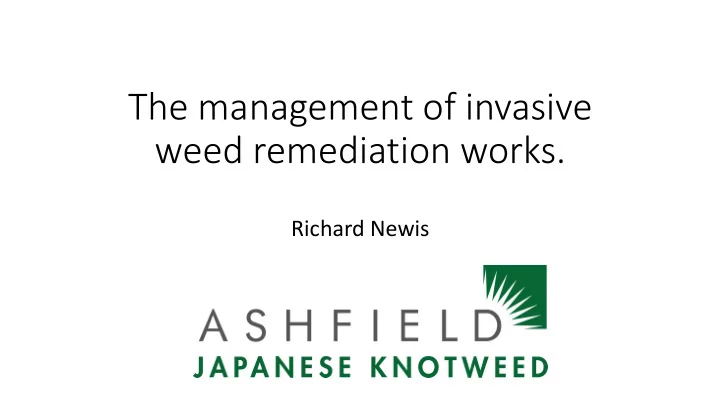

The management of invasive weed remediation works. Richard Newis
Objectives of the presentation
Health & Safety Executive Website States: Every year people are killed or seriously injured by collapses and falling materials while working in excavations. They are at risk from: Excavations collapsing and burying or injuring people working in them; material falling from the sides into any excavation; and people or plant falling into excavations. Remember: No ground can be relied upon to stand unsupported in all circumstances. Depending on conditions, a cubic metre of soil can weigh in excess of 1.5 tonnes. The law says you must prevent danger to workers in or near excavations. To maintain the required precautions, a competent person must inspect excavation supports or battering at the start of the working shift and at other specified times. No work should take place until the excavation is safe. Ensure you employ someone competent in the planning and delivery of excavations.
Other Invasive UXO Geology Segregation Species Supervision Biosecurity Utilities Hydrogeology Edge & Hydrology protection Risk Contamination PLANNING Assessments EXCAVATION WORKS Method Materials Statements Management Collapse Plan Mine Shafts Flood Regulatory Waste Defences Dialogue Adjacent Obstructions Structures
EVERY SITE IS UNIQUE AND EVERY SITE HAS DIFFERENT CHALLENGES!
Extent of Excavation Joe Bloggs Japanese Knotweed Remediation states “The Environment Agency states that JK rhizomes will be spread 7m from the above ground growth and 3m deep.” EA’s ‘Managing Japanese knotweed on development sites’ It is hard to state with certainty the likely extent of rhizome spread from the parent plant. Research has shown that rhizome can grow a distance of at least 7m (23 feet) and achieve a depth of at least 2m (6 feet) from the parent crown. However, the actual extent of the rhizome can vary considerably depending on the soil type and the history of the site.
Soils Re-use Is this soil a waste? 1. Does it pose a risk to the environment or human health if re-used? 2. Is it geotechnically suitable for reuse at the site? 3. Is the material required to facilitate agreed development levels?
Wastes If you produce waste, it is your legal duty to classify the waste. Waste Acceptance Criteria is not a test for classifying waste, it a test to see how a waste will behave in a landfill. Classifying Waste
Verification Reporting Verification reporting should not be under estimated as it is a key document to demonstrate works have been undertaken professionally, legally and safely. A verification report should include as a minimum: 1. Detailed plans of the extent of excavation; haul routes; deposition areas; and stockpiling areas. 2. Summary of waste movements at the Site. 3. Photo record of the works. 4. EVIDENCE THAT SOILS REUSED AT A SITE ARE NOT WASTE. 5. ALL DUTY OF CARE RECORDS FOR WASTES REMOVED FROM THE SITE. 6. EVIDENCE BURIAL CELLS HAVE BEEN RECORDED WITH THE LAND REGISTRY. 7. COPIES OF WASTE HAULIERS AND LANDFILLS LICENCES.
Summary 1. Ensure you employ someone competent in the planning and implementation of excavation works. 2. Treat every site on its own merits and plan the works accordingly. 3. Regulators have been notified of the works where applicable. 4. Ensure you have contingency plans should additional excavations be required to remove rhizomes. 5. If soils are to be reused at the site ensure they do not meet the definition of a waste. 6. If soils are removed from a site ensure correct waste classification has been undertaken and all documentation retained. 7. Ensure your verification reporting can demonstrate that works were undertaken professionally, legally and safely.
Thank you for listening. Richard Newis, Ashfield Japanese Knotweed Registered office: 76 Bishops Road, Whitchurch, Cardiff, CF14 1LY www.ashfieldjk.co.uk Tel: 07852 972 704 richard.newis@ashfieldjk.com
Recommend
More recommend